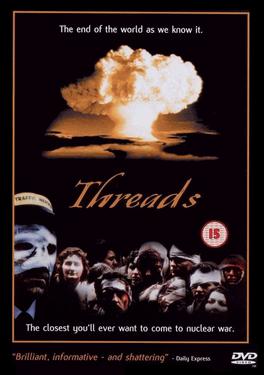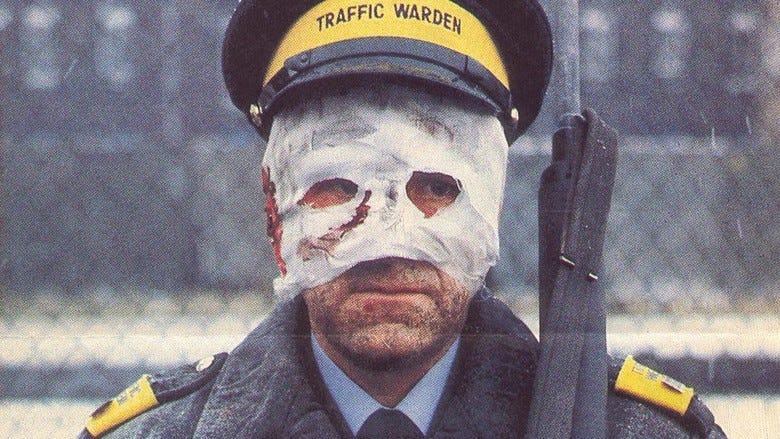Threads
Threads Hybrid, 1984, 3 ¼ stars
Nuclear apocalypse, by BBC
Threads is British answer to The Day After
Exclusive to MeierMovies, May 13, 2025
Ever see your hometown destroyed in a nuclear war? I did.
The year was 1983, and the movie was ABC’s The Day After, set and filmed in and around Lawrence, Kansas, my home.
Though the film was traumatic for Kansans, you didn’t have to live in the Sunflower State to be emotionally moved by nuclear holocaust. Television viewers all around the United States felt the gut punch.
Those outside the United States didn’t, however. So, one year later, the BBC aired an even grittier and arguably more realistic look at nuclear war, with emphasis on the long-term aftermath.
The film was Threads. Though largely forgotten today, and stylistically odd (partially because of its low budget), the film is a suitable, and terrifying, companion piece to both The Day After and an even earlier BBC-produced film, The War Game (1966), which inspired both later movies. That older film was so disturbing for its time, apparently, that the BBC didn’t air it. Instead, it got a limited release in cinemas and festivals.
 Directed and produced by Mick Jackson (L.A. Story, The Bodyguard) and written by Barry Hines, Threads was filmed in and around Sheffield, in northern England, on a threadbare budget (no pun intended), which influenced its choices. For example, it relies too much on voiceover narration (Paul Vaughan), on-screen text (some of which becomes rather tedious), still photography and surprisingly brief scenes with abrupt cuts. (Remember the long tracking shot of Dunkirk beach in Joe Wright’s Atonement? Threads’ depiction of destruction is the opposite of that.)
Directed and produced by Mick Jackson (L.A. Story, The Bodyguard) and written by Barry Hines, Threads was filmed in and around Sheffield, in northern England, on a threadbare budget (no pun intended), which influenced its choices. For example, it relies too much on voiceover narration (Paul Vaughan), on-screen text (some of which becomes rather tedious), still photography and surprisingly brief scenes with abrupt cuts. (Remember the long tracking shot of Dunkirk beach in Joe Wright’s Atonement? Threads’ depiction of destruction is the opposite of that.)
Nevertheless, the film offers a frightening, no-frills, neo-realistic approach to the subject, focusing mostly on two families. The ensemble cast is effective, with Karen Meagher getting the largest role, as the newly engaged, newly pregnant Ruth, who, following the nuclear holocaust, gives birth to her baby in a barn beside a barking dog. And in an “I can’t believe they showed that on 1980s television” moment, she bites through her own umbilical cord. (The prop was apparently licorice.)
Though the screenplay suffers both from the film’s low budget and its rushed, slide-show feel in the third act, it retains a lot of the folk feel of Hines’ superior Kes (1969), which he wrote with legendary British director Ken Loach. It also tends to jumble its characters and not bring clear resolutions to all their stories. But the script, with its docu-drama vibe, gets its details right, thanks to the production’s exhaustive research. (Jackson had previous experience with the topic, directing an episode of the popular British science documentary program Q.E.D.) For instance, its speculation that language would devolve several years after nuclear war is both shocking and likely accurate. And above all, over its 112 minutes, it continues to emotionally escalate the inescapable tragedy. This visceral relentlessness is its cinematic modus operandi.
 As a devotee of The Day After, what struck me the most about Threads was its similarity to that earlier American film, including subplots involving a pending marriage, pregnancy, being trapped in a basement, learning how to plant crops, etc. But because Threads was in the works for years, The Day After was not as big an influence as one might assume. Instead, the resemblances might be due simply to circumstance. It seems there are a finite number of ways to depict, in a relatable way, the destruction of the human race. Though it is regrettable that The Day After, by beating Threads by 10 months, stole some of its thunder, the latter’s style and its longer exploration of the societal impacts of nuclear war (over 13 years rather than just months) set it apart from the American movie.
As a devotee of The Day After, what struck me the most about Threads was its similarity to that earlier American film, including subplots involving a pending marriage, pregnancy, being trapped in a basement, learning how to plant crops, etc. But because Threads was in the works for years, The Day After was not as big an influence as one might assume. Instead, the resemblances might be due simply to circumstance. It seems there are a finite number of ways to depict, in a relatable way, the destruction of the human race. Though it is regrettable that The Day After, by beating Threads by 10 months, stole some of its thunder, the latter’s style and its longer exploration of the societal impacts of nuclear war (over 13 years rather than just months) set it apart from the American movie.
Threads hit American television the following year (1985), about the same time that The War Game finally aired on British TV. With three powerful films about nuclear destruction burned into the brains of the viewing public on both sides of the Atlantic in the mid-1980s, it’s little wonder that Mikhail Gorbachev and Ronald Reagan (who said he watched The Day After) took the world a few steps back from the nuclear precipice. We cinephiles like to say that cinema can save the world. In the 1980s, it actually did.
© 2025 MeierMovies, LLC
For more information on the film, visit IMDB and Wikipedia. Threads is available on the free streaming service Kanopy. Following its television screenings, Threads played a limited number of cinemas and festivals, as did The Day After, thus my “hybrid” designation for both movies (originally aired on television, the internet, a streaming service or on DVD/Blu-ray but subsequently received a theatrical release (general, limited or at at least two major festivals)). For more information on The Day After, I recommend the excellent documentary Television Event, from 2021.
